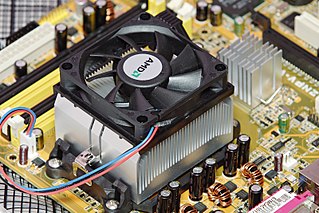Related Research Articles

A mainframe computer, informally called a mainframe or big iron, is a computer used primarily by large organizations for critical applications like bulk data processing for tasks such as censuses, industry and consumer statistics, enterprise resource planning, and large-scale transaction processing. A mainframe computer is large but not as large as a supercomputer and has more processing power than some other classes of computers, such as minicomputers, servers, workstations, and personal computers. Most large-scale computer-system architectures were established in the 1960s, but they continue to evolve. Mainframe computers are often used as servers.
In software quality assurance, performance testing is in general a testing practice performed to determine how a system performs in terms of responsiveness and stability under a particular workload. It can also serve to investigate, measure, validate or verify other quality attributes of the system, such as scalability, reliability and resource usage.
Scalability is the property of a system to handle a growing amount of work. One definition for software systems specifies that this may be done by adding resources to the system.

The thermal design power (TDP), sometimes called thermal design point, is the maximum amount of heat generated by a computer chip or component that the cooling system in a computer is designed to dissipate under any workload.

In computing, a benchmark is the act of running a computer program, a set of programs, or other operations, in order to assess the relative performance of an object, normally by running a number of standard tests and trials against it.
Online transaction processing (OLTP) is a type of database system used in transaction-oriented applications, such as many operational systems. "Online" refers to that such systems are expected to respond to user requests and process them in real-time. The term is contrasted with online analytical processing (OLAP) which instead focuses on data analysis.
Replication in computing involves sharing information so as to ensure consistency between redundant resources, such as software or hardware components, to improve reliability, fault-tolerance, or accessibility.
AIDA64 is a system information, diagnostics, and auditing application developed by FinalWire Ltd that runs on Windows, Android, iOS, ChromeOS, Windows Phone, Sailfish OS, Ubuntu Touch and Tizen operating systems. It displays detailed information on the components of a computer. Information can be saved to file in formats such as HTML, CSV, or XML.
SAP IQ is a column-based, petabyte scale, relational database software system used for business intelligence, data warehousing, and data marts. Produced by Sybase Inc., now an SAP company, its primary function is to analyze large amounts of data in a low-cost, highly available environment. SAP IQ is often credited with pioneering the commercialization of column-store technology.
In computing, computer performance is the amount of useful work accomplished by a computer system. Outside of specific contexts, computer performance is estimated in terms of accuracy, efficiency and speed of executing computer program instructions. When it comes to high computer performance, one or more of the following factors might be involved:
Transaction Processing over XML (TPoX) is a computing benchmark for XML database systems. As a benchmark, TPoX is used for the performance testing of database management systems that are capable of storing, searching, modifying and retrieving XML data. The goal of TPoX is to allow database designers, developers and users to evaluate the performance of XML database features, such as the XML query languages XQuery and SQL/XML, XML storage, XML indexing, XML Schema support, XML updates, transaction processing and logging, and concurrency control. TPoX includes XML update tests based on the XQuery Update Facility.
Web server benchmarking is the process of estimating a web server performance in order to find if the server can serve sufficiently high workload.
The Transaction Processing Performance Council (TPC), founded in 1988, is a non-profit organization founded to define benchmarks for transaction processing and databases, and to publish objective, verifiable TPC performance data to the industry. TPC benchmarks are used in evaluating the performance of computer systems, and TPC publishes the results.

Samuel R. Madden is an American computer scientist specializing in database management systems. He is currently a professor of computer science at the Massachusetts Institute of Technology.
H-Store is an experimental database management system (DBMS). It was designed for online transaction processing applications. H-Store was developed by a team at Brown University, Carnegie Mellon University, the Massachusetts Institute of Technology, and Yale University in 2007 by researchers Michael Stonebraker, Sam Madden, Andy Pavlo and Daniel Abadi.
Transactional Synchronization Extensions (TSX), also called Transactional Synchronization Extensions New Instructions (TSX-NI), is an extension to the x86 instruction set architecture (ISA) that adds hardware transactional memory support, speeding up execution of multi-threaded software through lock elision. According to different benchmarks, TSX/TSX-NI can provide around 40% faster applications execution in specific workloads, and 4–5 times more database transactions per second (TPS).

Oracle NoSQL Database is a NoSQL-type distributed key-value database from Oracle Corporation. It provides transactional semantics for data manipulation, horizontal scalability, and simple administration and monitoring.

In computer science, the log-structured merge-tree is a data structure with performance characteristics that make it attractive for providing indexed access to files with high insert volume, such as transactional log data. LSM trees, like other search trees, maintain key-value pairs. LSM trees maintain data in two or more separate structures, each of which is optimized for its respective underlying storage medium; data is synchronized between the two structures efficiently, in batches.
Hybrid transaction/analytical processing (HTAP) is a term created by Gartner Inc., an information technology research and advisory company, in its early 2014 research report Hybrid Transaction/Analytical Processing Will Foster Opportunities for Dramatic Business Innovation. As defined by Gartner:
Hybrid transaction/analytical processing (HTAP) is an emerging application architecture that "breaks the wall" between transaction processing and analytics. It enables more informed and "in business real time" decision making.
HammerDB is an open source database benchmarking application developed by Steve Shaw. HammerDB supports databases such as Oracle, SQL Server, Db2, MySQL and MariaDB. HammerDB is written in TCL and C, and is licensed under the GPL v3.
References
- ↑ Toni Strandell: "Open Source Database Systems: Systems study, Performance and Scalability". Master's Thesis, University of Helsinki, Department of Computer Science, May 2003, 54 p, at: http://ethesis.helsinki.fi/julkaisut/mat/tieto/pg/strandell/
- ↑ "Network Database Benchmark", an open-source project, at: http://sourceforge.net/projects/ndbb/
- ↑ Intel and IBM Collaborate to Double In-Memory Database Performance, Intel 2009 http://communities.intel.com/docs/DOC-2985
- ↑ Ippokratis Pandis, Ryan Johnson, Nikos Hardavellas, Anastasia Ailamaki: Data-Oriented Transaction Execution. PVLDB, 3(1), 2010.
- ↑ Ru Fang, Hui-I Hsiao, Bin He, C. Mohan, Yun Wang: A Novel Design of Database Logging System using Storage Class Memory. Proc. International Conference on Data Engineering (ICDE 2011), Hannover, Germany April 11–16, 2011.
- ↑ Kishore Kumar Pusukuri, Rajiv Gupta, Laxmi N. Bhuyan: No More Backstabbing... A Faithful Scheduling Policy for Multithreaded Programs. Proc. Parallel Architectures and Compilation Techniques (PACT 2011), Galveston Island, Texas, USA, October 10–14, 2011.
- ↑ Ryan Johnson, Ippokratis Pandis, Radu Stoica, Manos Athanassoulis, Anastasia Ailamaki: Scalability of write-ahead logging on multicore and multisocket hardware. VLDB Journal 21(2), 2011: 239-263.
- ↑ Per-Åke Larson, Spyros Blanas, Cristian Diaconu, Craig Freedman, Jignesh M. Patel, Mike Zwilling: High-Performance Concurrency Control Mechanisms for Main-Memory Databases. Proc. VLDB 2012 Conference, Istanbul, Turkey, Aug. 28-30, 2012, pp. 298-309.
- ↑ Kevin P. Gaffney, Martin Prammer, Larry Brasfield, D. Richard Hipp, Dan Kennedy, and Jignesh M. Patel. 2022. SQLite: past, present, and future. Proc. VLDB Endow. 15, 12 (August 2022), 3535–3547. https://doi.org/10.14778/3554821.3554842